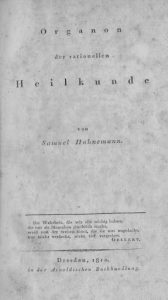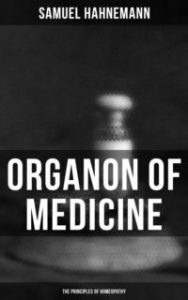Introduction and summary
The Organon of the Healing Art, written by Samuel Hahnemann, serves as the cornerstone of classical homeopathy. This foundational text lays out timeless principles that remain relevant today, as the method is based on natural laws and universal principles, independent of trends and time. From its first edition in 1810 to its final version in 1921, the Organon reflects Hahnemann’s ongoing quest for refinement and improvement of his methods.
The book outlines, among other things, the seven core principles of homeopathy. Another significant concept in Hahnemann’s Organon is the notion of “miasma.” His discussion on this topic highlights his attempts to explain hereditary diseases—an area we now better understand through genetics and epigenetics.
The Organon remains an essential part of the training for classical homeopaths. Despite the challenges posed by its archaic language, it continues to be a valuable guide for practitioners of classical homeopathy.
Table of Contents
Background of the Organon in classical homeopathy
 The Organon is a foundational text in classical homeopathy, written by Samuel Hahnemann, the founder of homeopathy. This book outlines the core principles of classical homeopathy. Although it is an important work, it can be challenging to read, and we must remember that it was written in the context of a specific historical period. Nevertheless, it is remarkable how accurate and forward-thinking the book remains. Its content is timeless and still relevant, even though two centuries have passed since its creation.
The Organon is a foundational text in classical homeopathy, written by Samuel Hahnemann, the founder of homeopathy. This book outlines the core principles of classical homeopathy. Although it is an important work, it can be challenging to read, and we must remember that it was written in the context of a specific historical period. Nevertheless, it is remarkable how accurate and forward-thinking the book remains. Its content is timeless and still relevant, even though two centuries have passed since its creation.
In conventional medicine, diseases are often matched with specific remedies, following a “medicine X for disease Y” approach. This strategy tends to become outdated quickly, as it relies heavily on trends and new insights. Hahnemann chose a different path. He based his method on natural laws and universal principles that are not bound by time or fashion.
First published in 1810, the Organon serves as a key foundation for homeopathy. The book challenges the medical practices and philosophies of the early 19th century, a time when conventional treatments were often invasive and harmful. Hahnemann developed his homeopathic principles as an alternative to these aggressive approaches, emphasizing the stimulation of the body’s self-healing ability.
The Organon describes the seven core principles of classical homeopathy:
- Individualization: Each patient is unique, and the treatment must be tailored to the specific characteristics of the individual.
- Proving of remedies: Testing remedies on healthy individuals to understand their effects.
- Similimum: The remedy that best matches the patient’s symptoms.
- Simplex: Prescribing only one remedy at a time.
- Minimum dose: Using the smallest possible dose that can stimulate healing.
- Potentization: The process of making a remedy more effective through shaking or triturating (grinding).
- Vital Force: The concept that health is determined by a dynamic life force that must remain in balance.
Different editions of the Organon
 The Organon was published in six editions, with each edition building upon Hahnemann’s evolving insights. The first edition, released in 1810, introduced the fundamental principles of homeopathy, including the “similia similibus curentur” principle (“like cures like”). In the second through fourth editions, Hahnemann included clarifications and expansions to describe his treatment method in greater detail. These editions placed increased emphasis on the role of the vital force and the need to tailor treatment to the individual patient.
The Organon was published in six editions, with each edition building upon Hahnemann’s evolving insights. The first edition, released in 1810, introduced the fundamental principles of homeopathy, including the “similia similibus curentur” principle (“like cures like”). In the second through fourth editions, Hahnemann included clarifications and expansions to describe his treatment method in greater detail. These editions placed increased emphasis on the role of the vital force and the need to tailor treatment to the individual patient.
The fifth edition, published in 1833, introduced the concept of potentization, which refers to the process of making remedies more effective through repeated dilution and succussion (vigorous shaking). This method aimed to enhance the therapeutic effects of the remedies while eliminating toxic side effects.
The sixth and final edition, completed shortly before Hahnemann’s death but only published in 1921, introduced the use of LM potencies (also known as Q potencies). This was a new form of dynamization that Hahnemann considered more efficient and gentler for the patient. This edition reflects his ongoing pursuit of making treatment as mild as possible while retaining its healing power.
The fifth or sixth edition of the Organon
In some schools and authors, there is debate over which edition of the Organon should be used. On the one hand, the fifth edition is the last version fully published under Hahnemann’s supervision. On the other hand, the sixth edition is based on Hahnemann’s most comprehensive notes but was only published many years after his death. This delay has led to discrepancies between the sixth edition and Hahnemann’s actual practices.
Both versions present challenges: the fifth edition contains outdated information but remains directly tied to Hahnemann’s oversight. The sixth edition incorporates his most recent insights, yet there are suspicions that certain revisions may have been made by others, including his second wife, who worked closely with him. For example, there appears to be a difference between what is stated in the sixth edition regarding the use of LM (or Q) potencies and what Hahnemann himself practiced.
Structure and writing style of the Organon
 Hahnemann wrote the Organon in a highly structured style, including many footnotes and detailed explanations to convey his ideas as clearly as possible. He employed repetition as a technique to emphasize key concepts and prevent misunderstandings. Instead of dividing the text into chapters, Hahnemann opted for numbered paragraphs, guiding the reader step by step through his reasoning. Although this format can be challenging to read, it ensures that the reader can fully grasp the logic behind his methods.
Hahnemann wrote the Organon in a highly structured style, including many footnotes and detailed explanations to convey his ideas as clearly as possible. He employed repetition as a technique to emphasize key concepts and prevent misunderstandings. Instead of dividing the text into chapters, Hahnemann opted for numbered paragraphs, guiding the reader step by step through his reasoning. Although this format can be challenging to read, it ensures that the reader can fully grasp the logic behind his methods.
The theoretical section (§1–70) is structured as follows:
- Mission (§1–2): Outlines the purpose of the physician.
- Knowledge of the practitioner (§3–4): Details the necessary skills and understanding for the healer.
- Knowledge of the disease (§5–18): Discusses the nature of diseases and how they manifest.
- Knowledge of remedies (§19–21): Explains how remedies are understood and classified.
- Similar and dissimilar symptoms (§22–27): Differentiates between symptoms that match the remedy and those that do not.
- Therapeutic methods (§28–69): Outlines various approaches to treatment.
- Summary of the previous concepts (§70): Provides a brief review of the discussed principles.
The practical section (§71–291) is structured as follows:
- Requirements for healing (§71): Describes what is necessary for effective treatment.
- Acute and chronic diseases (§72–82): Differentiates between short-term and long-term illnesses.
- Anamnesis (§83–104): Details the process of taking a patient’s case history.
- Proving of remedies (§105–145): Explains the testing of remedies on healthy individuals.
- Best method for healing (§146–285): Discusses the optimal approach for treating patients.
- Selection and administration of remedies (§146–171): Covers how to choose and apply remedies.
- Unilateral and recurrent diseases (§172–263): Focuses on specific types of illnesses.
- Remedies and potentization (§264–285): Describes the preparation and enhancement of remedies.
- Other Therapies (§286–291):
- Magnetism and electricity (§286–287): Discusses the therapeutic use of magnetic fields and electrical currents.
- Mesmerism (§288–289): Details the use of hypnotic techniques.
- Massage (§290): Covers the benefits of physical manipulation.
- Bathing (§291): Explains the therapeutic use of baths.
This structured approach reflects Hahnemann’s meticulous attention to detail and his desire to provide a comprehensive guide for practitioners of classical homeopathy.
Context and challenges of the Organon
The concept of “Miasma”
 During Hahnemann’s time, the term “miasma” was commonly used. Historically, “miasma” referred to a harmful vapor or pollution believed to cause diseases. In the early 19th century, it was thought that illnesses such as cholera and the plague spread through these miasmas, which were depicted as clouds of infectious particles. Hahnemann used the concept of miasma to explain hereditary and chronic diseases, referring to deep-seated disturbances in health that could be passed down through generations. He observed that certain vulnerabilities could be inherited within families, such as a predisposition in a specific organ or a type of ailment. Due to the lack of advanced technology, Hahnemann could not identify that this phenomenon was actually a matter of genetics and epigenetics.
During Hahnemann’s time, the term “miasma” was commonly used. Historically, “miasma” referred to a harmful vapor or pollution believed to cause diseases. In the early 19th century, it was thought that illnesses such as cholera and the plague spread through these miasmas, which were depicted as clouds of infectious particles. Hahnemann used the concept of miasma to explain hereditary and chronic diseases, referring to deep-seated disturbances in health that could be passed down through generations. He observed that certain vulnerabilities could be inherited within families, such as a predisposition in a specific organ or a type of ailment. Due to the lack of advanced technology, Hahnemann could not identify that this phenomenon was actually a matter of genetics and epigenetics.
Genetics is the study of genes and how traits are passed from parents to offspring. Epigenetics, on the other hand, deals with changes in gene expression that are not caused by alterations in the DNA sequence itself but rather by environmental factors or lifestyle choices. This means that an individual’s experiences can influence how genes are switched on or off, and these changes can also be inherited by future generations. Given the limitations of his time, it was logical for Hahnemann to refer to this phenomenon as miasma, but with our current understanding, we would more accurately describe it as hereditary predisposition.
Hahnemann as a pioneer
 Hahnemann was a true pioneer. He developed homeopathy and dedicated his entire professional life to testing and refining its theories and practices. He frequently experimented with new methods, but later revised or abandoned them (such as prescribing two remedies simultaneously or having patients inhale remedies). The changes seen across the different editions of the Organon reflect his continuous quest for improvement. This is not a sign of weakness but rather evidence of his curiosity and his ability to critically assess the outcomes of new methods and theories. However, for some, the drawback of Hahnemann’s pioneering work lies in its lack of consistency. Due to the modifications he made over time, there are significant differences between his early and later insights. This makes it essential to always place his ideas and recommendations within the proper context.
Hahnemann was a true pioneer. He developed homeopathy and dedicated his entire professional life to testing and refining its theories and practices. He frequently experimented with new methods, but later revised or abandoned them (such as prescribing two remedies simultaneously or having patients inhale remedies). The changes seen across the different editions of the Organon reflect his continuous quest for improvement. This is not a sign of weakness but rather evidence of his curiosity and his ability to critically assess the outcomes of new methods and theories. However, for some, the drawback of Hahnemann’s pioneering work lies in its lack of consistency. Due to the modifications he made over time, there are significant differences between his early and later insights. This makes it essential to always place his ideas and recommendations within the proper context.
Another notable and influential homeopath is James Tyler Kent. Unlike Hahnemann, Kent benefited from an already well-established theory. This allowed him to focus on gaining practical experience and refining the application of homeopathy. A good example of this is Hahnemann’s practice of dissolving remedies before administering them, likely because it was more practical during the preparation of the remedies. Kent was aware of Hahnemann’s method but found in practice that it made no difference whether a remedy was taken dry or dissolved. Kent’s approach to stepping beyond conventional practices was largely shaped by his extensive experience treating patients.
The Organon and the education of a classical homeopath
 In the training of classical homeopaths, a thorough study of the Organon is essential. It serves as the foundation of classical homeopathy and provides a wealth of valuable information on how to approach treatment. However, it is equally important to place this information in the correct context—both the historical context of the time in which it was written and the context of the individual paragraphs in relation to one another.
In the training of classical homeopaths, a thorough study of the Organon is essential. It serves as the foundation of classical homeopathy and provides a wealth of valuable information on how to approach treatment. However, it is equally important to place this information in the correct context—both the historical context of the time in which it was written and the context of the individual paragraphs in relation to one another.
We take the study of the Organon very seriously, and throughout the training program, we explore all aspects of this significant work.
Studying the Organon not only aids in understanding the core principles of homeopathy but also encourages critical thinking about its application in the present day. It is crucial to remain open to new insights and to interpret these within the framework of Hahnemann’s teachings. This approach helps in becoming an effective and responsible practitioner.

